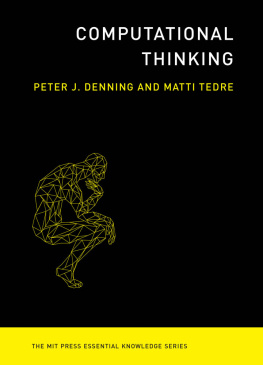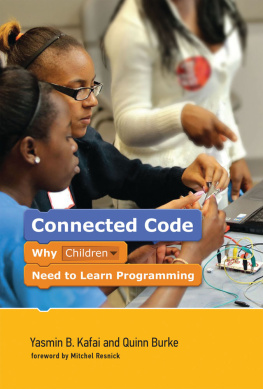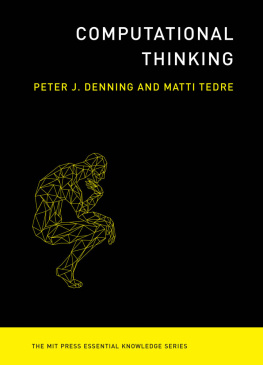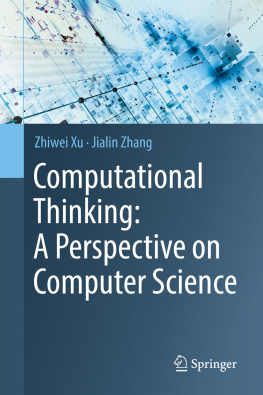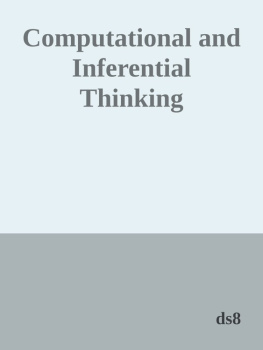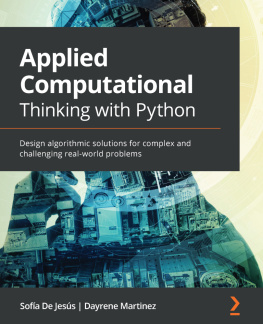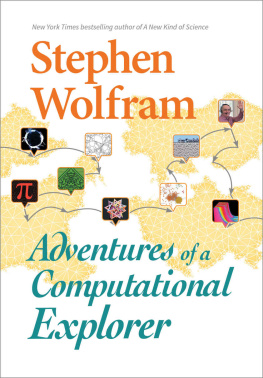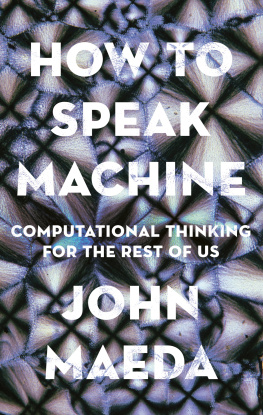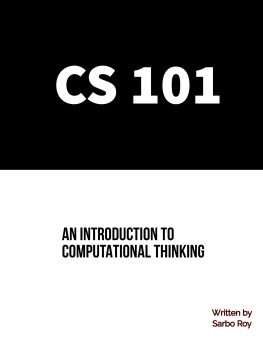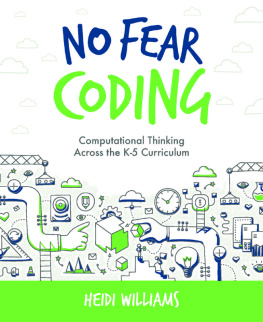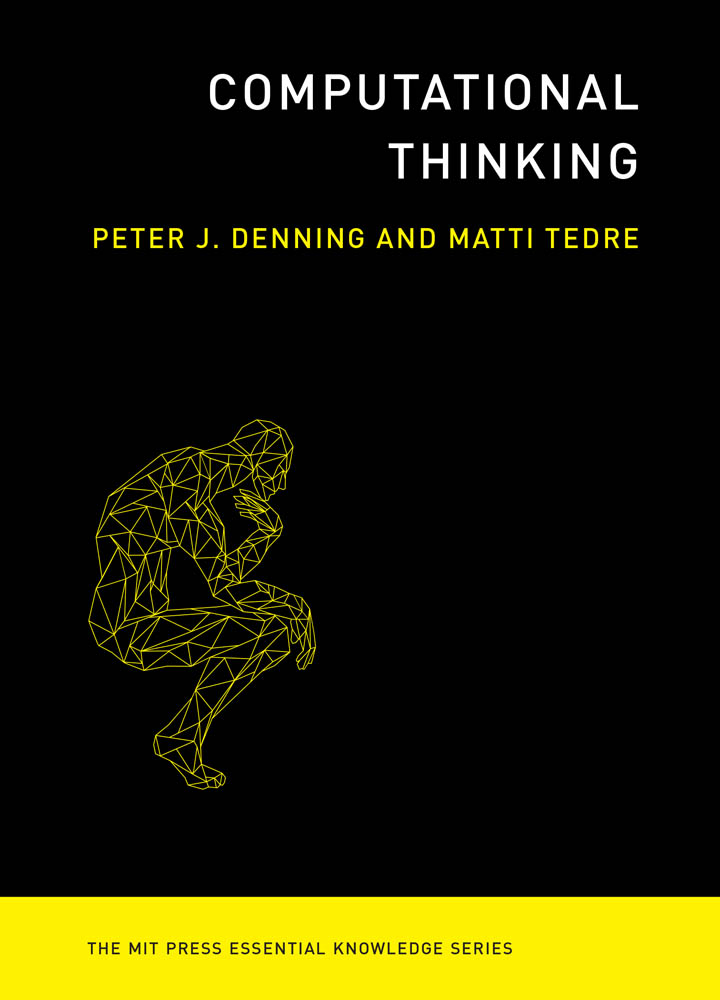
Computational Thinking
The MIT Press Essential Knowledge Series
A complete list of the titles in this series appears at the back of this book.
Computational Thinking
Peter J. Denning and Matti Tedre
The MIT Press | Cambridge, Massachusetts | London, England
2019 The Massachusetts Institute of Technology
All rights reserved. No part of this book may be reproduced in any form by any electronic or mechanical means (including photocopying, recording, or information storage and retrieval) without permission in writing from the publisher.
This book was set in Chaparral Pro by Toppan Best-set Premedia Limited. Printed and bound in the United States of America.
Library of Congress Cataloging-in-Publication Data
Names: Denning, Peter J., 1942- author. | Tedre, Matti, author.
Title: Computational thinking / Peter J. Denning and Matti Tedre.
Description: Cambridge, MA : The MIT Press, 2019. | Series: The MIT press essential knowledge series | Includes bibliographical references and index.
Identifiers: LCCN 2018044011 | ISBN 9780262536561 (pbk. : alk. paper)
Subjects: LCSH: Computer algorithmsPopular works. | Computer logicPopular works. | Electronic data processingSocial aspectsPopular works.
Classification: LCC QA76.9.L63 D46 2019 | DDC 005.1dc23 LC record available at https://lccn.loc.gov/2018044011
10 9 8 7 6 5 4 3 2 1
Contents
Series Foreword
The MIT Press Essential Knowledge series offers accessible, concise, beautifully produced pocket-size books on topics of current interest. Written by leading thinkers, the books in this series deliver expert overviews of subjects that range from the cultural and the historical to the scientific and the technical.
In todays era of instant information gratification, we have ready access to opinions, rationalizations, and superficial descriptions. Much harder to come by is the foundational knowledge that informs a principled understanding of the world. Essential Knowledge books fill that need. Synthesizing specialized subject matter for nonspecialists and engaging critical topics through fundamentals, each of these compact volumes offers readers a point of access to complex ideas.
Bruce Tidor
Professor of Biological Engineering and Computer Science
Massachusetts Institute of Technology
Preface
A computer revolution is in full swing. The invasion of computing into every part of our lives has brought enormous benefits including email, internet, World Wide Web, Amazons e-commerce, Kahn Academy, Ubers taxi hailing, Googles maps, trip navigators, smartphones, real-time translators, and apps by the millions. At the same time it has also brought enormous concerns including possible loss of jobs to automation, mass surveillance, collapse of critical infrastructure, cyber war, mass sales of personal data, invasions of advertising, loss of privacy, polarization of politics, loss of civility and respectful listening, and exacerbated income inequality.
A lot of people are having trouble coming to grips with all this. Can they reap the benefits without the downside costs? Can they lead a meaningful life if computerization suddenly threatens to obsolete a lifetime of learning? What should their children learn about computing to enable them to move and prosper in the new world?
Computational thinking is a new term that has recently entered public discourse as people struggle with these questions. It holds the hope that we can think clearly about the powers and dangers of mass computing, and that we can learn to design computers, software, and networks to maximize the benefits and minimize the risks. Parents are already amazed at how facile their children seem to be in the digital world. Is computational thinking the recipe for giving our children a proper education in this world?
We designed this book to be an edifying conversation to help you understand what computational thinking is so that you will be in a better position to answer these questions for yourself.
The first thing to understand is that a substantial part of daily discourse is shaped by the wide adoption of computers. This is nothing new; our ancestors ways of thinking about the world were shaped by the technologies of previous revolutions. In the industrial age, for example, people regularly used expressions like
He blew a gasket,
Im humming on all pistons,
Its a high pressure environment, and
I had to blow off steam.
Today we hear expressions like
My DNA programs me to do it this way,
Our laws are algorithms for running our society,
My brain is hardware and my mind software, and
My brain crashed, I need to reboot.
Just as in the industrial age, the new idioms of the computer age reveal more about our popular culture than they do about the technology.
Like the Greek god Janus, computational thinking has two faces, one that looks behind and explains all that has happened, and one that looks ahead to what can be designed. We invoke both faces when we want to get computers to do jobs for us. On the back-facing side, we need to understand the mechanics of how computers work, how they are controlled by algorithms, how we can express algorithms in a programming language, and how we can combine many software modules into working systems. On the forward-facing side, we need sensibilities to understand the context in which users of our software are working. We want our software to be valuable to them and not to cause harm to them or their environment. Thus, computational thinking guides us to understand the technology available to us and to design software to do a job or solve a problem.
Computational thinking is not only something programmers must know, but it is also a thinking tool for understanding our technology-infused social world. It increases our awareness of how our everyday digital tools work, grounds our cyber ethics, and improves our resilience against various threats such as algorithm-driven attempts to guide our behavior, personally tailored fake news, viral powers of social media, and massive, data-intensive analysis of our movements. What is more, computational thinking has irrevocably changed the tools, methods, and epistemology of science. Learning CT has many benefits beyond programming.
If you try to understand what computational thinking is from media accounts, you will hear a story of problem solving with algorithms, along with the ability to think at the many levels of abstraction needed to solve problems. The story is flavored with images of joyous children having fun programming and playing games in which they simulate algorithms. Indeed, our teachers have learned much about computational thinking from teaching computing to children, and they have developed superb ways of teaching fundamental computing insights to newcomers. In this book, we call this CT for beginners.
But the K12 education insights and debates barely scratch the surface of computational thinking. At the more advanced levels, computational thinking concerns the design of hardware, networks, storage systems, operating systems, and the cloud. Its historical predecessors have organized human teams to do large computations, organized production lines in manufacturing, guided lawmakers, and specified the rules of bureaucracies. It has developed styles attuned to major areas where computing plays a critical role, such as artificial intelligence, large data analytics, software engineering, and computational science. We will show you all this by examining the kinds of computational thinking needed to deal with these different dimensions of computing. A much more advanced kind of computational thinking is needed to deal with these areas. We call it CT for professionals.
Next page
